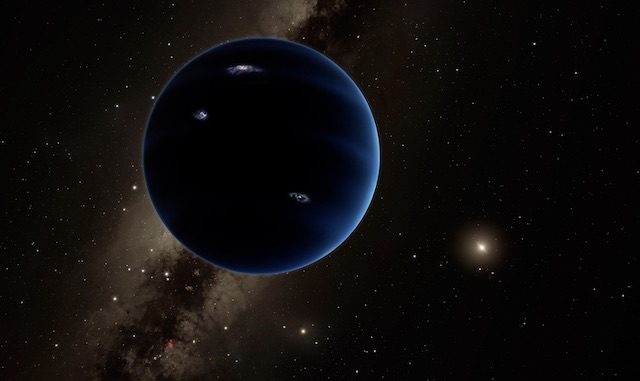SUMMARY
This is AI generated summarization, which may have errors. For context, always refer to the full article.

MANILA, Philippines – A huge planet, with an odd orbit that takes it around the Sun, might just be lurking in the outer edges of our solar system, scientists revealed on Wednesday, January 20.
In a paper published in Astronomical Journal, scientists Konstantin Batygin and Mike Brown revealed that the object, named “Planet Nine,” has a mass around 10 times that of our Earth, with a “bizarre, highly elongated” orbit 20 times farther than Neptune’s.
For it to make one full orbit around the Sun, it would take 10,000 to 20,000 years, according to a statement from the California Institute of Technology (CalTech), where the duo works.
The discovery was made through mathematical modeling and computer simulations.
Other planets have been discovered by mathematical modeling, including Neptune in 1846, but not every prediction has led to an actual planet.
The discovery of Planet Nine started in 2014, when a study revealed that something was disrupting the orbits of objects in the Kuiper Belt, an area beyond Neptune’s orbit populated with what is essentially debris and ice cast off during the formation of the solar neighborhood.
At first, Batygin and Brown thought that the anomalies in the Kuiper Belt objects’ orbits can be attributed to the possibility of having enough distant objects clustering together to exert gravity to disturb the orbits. Physics told them otherwise, leading them to the idea of a planet.
After running simulations involving different orbital scenarios for the mysterious object, the two scientists later discovered that it had an “anti-aligned orbit – an orbit in which the planet’s closest approach to the Sun, or perihelion, is 180 degrees across from the perihelion of all the other objects and known planets.”
In addition to this, a mechanism called the mean-motion resonance helps prevent the Kuiper Belt objects from colliding with one another.
“Like a parent maintaining the arc of a child on a swing with periodic pushes, Planet Nine nudges the orbits of distant Kuiper Belt objects such that their configuration with relation to the planet is preserved,” CalTech said in a statement.
Makes solar system more ‘mainstream’
Planet Nine, the researchers said, could have been one of the planetary cores that formed the 4 gas giants – Jupiter, Saturn, Uranus, and Neptune. They hypothesize that Planet Nine could have been the fifth, but that it got too close to Jupiter or Saturn that led it to being ejected to its current, distant, and odd orbit.
Planet Nine, they said, “gravitationally dominates” its neighborhood, with a region comparatively larger that any of the other known planets, making it, as Brown said, “the most planet-y of the planets in the whole solar system.”
If proven to actually exist, it will be the third “true planet” discovered by humans since ancient times, CalTech said. (Uranus was discovered in 1781, Neptune in 1846; the rest have been known since antiquity).
Despite Planet Nine being an “oddball,” it actually makes our solar system more similar to other planetary systems in other stars.
This is because most other planets out there have varying orbits around their stars. In addition, most planets outside the solar system “range between 1 and 10 Earth-masses,” which is somewhere between that of the Earth and that of Neptune.
“Until now, we’ve thought that the solar system was lacking in this most common type of planet,” Batygin said. “Maybe we’re more normal after all.”
A host of powerful telescopes are currently hunting for it, including the twin 10-meter telescopes at the W. M. Keck Observatory and the Subaru Telescope on Mauna Kea in Hawaii.
“It’s a pretty substantial chunk of our solar system that’s still out there to be found, which is pretty exciting,” said Brown.
The object would be “sufficiently large,” that there would be no debate on whether to classify it as a planet or not.
Interestingly, Brown played a big role in the controversial 2006 demotion of Pluto, the original planet #9, into a dwarf planet.
“Now we can go and find this planet and make the solar system have 9 planets once again,” he said.
Still, sorry, Pluto, you remain a dwarf planet. – With reports from Agence France-Presse / Rappler.com
Add a comment
How does this make you feel?
There are no comments yet. Add your comment to start the conversation.